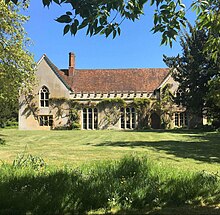Courtyard house
This article needs additional citations for verification. (October 2023) |

A courtyard house is a type of house—often a large house—where the main part of the building is disposed around a central courtyard. Many houses that have courtyards are not courtyard houses of the type covered by this article. For example, large houses often have small courtyards surrounded by service rooms or corridors, but the main rooms are not disposed around a courtyard. Blenheim Palace in England is an example of such a house.
The main rooms of a courtyard house often open onto the courtyard, and the exterior walls may be windowless and/or semi-fortified and/or surrounded by a
History


The courtyard house makes its first appearance ca. 6400–6000 BC (calibrated), in the
In Ancient Roman architecture courtyard houses were built around an atrium. Courtyard houses are also common in Islamic architecture.[2]
Courtyard houses consisting of multiple separate residences have been built in many regions and eras, including the earliest
Courtyard houses are also a form of dwelling built in the
.Another type of courtyard house was built by the landowners in

In the old towns of Morocco, known as medinas, courtyard houses have always been the standard form of housing. The traditional houses are called riads, riad being the name of interior gardens in Moorish architecture. Once neglected, Moroccan riads have experienced lately a real comeback with the tourism boom the country has been experiencing since the early 2000s. Many of these houses have been turned into guest houses, especially in cities likes Marrakesh, Essaouira, Fez and Tangier.
In rural villages of
See also
- Siheyuan: a style of Chinese courtyard house in Beijing.
- Riad: traditional courtyard houses in Morocco.
Notes
- ^ Garfinkel Y. 1993. "The Yarmukian Culture in Israel". Paléorient, 19.1:115–134.
- ^ "Courtyard Houses of Aleppo". Archived from the original on 2006-02-10. Retrieved 2007-02-11.
